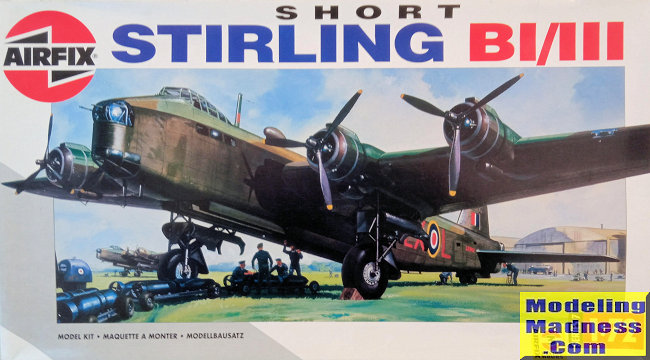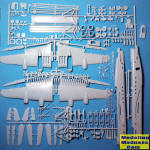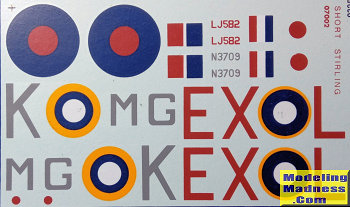
| KIT #: | 07002 |
| PRICE: | Around €30 in 2005 |
| DECALS: | Two options |
| REVIEWER: | Spiros Pendedekas |
| NOTES: | 1992 reissue of 1966 tooling |

| HISTORY |
Being the first four-engined
bomber to be introduced into service with the RAF, the Stirling was wisely
designed during the late 1930s as a result of promising foreign developments in
the 4-engine field, contrary the RAF’s intention back then to focus on
increasingly capable 2-engine designs.
By entering squadron service In early 1941, the Stirling was praised for its
ability to out-turn enemy night fighters and its favorable handling
characteristics in general. The low altitude ceiling for which the type was
often criticized, together with some other negative performance aspects, might,
at least partly, have been the result of questionable decisions by the Air
Ministry on certain performance requirements (most significantly restricting the
wingspan to 100ft).
The Stirling had a relatively brief operational career as a bomber, due to the
increasing availability of the more capable Halifax and Lancaster, which took
over the strategic bombing of Germany. From late 1943, the type was relegated to
second-line duties, including mining German ports, towing gliders and providing
supplies during the Allied invasion of Europe. It was rapidly withdrawn from RAF
service in the aftermath of the Second World, with several ex-military examples
rebuilt for the civilian market.
| THE KIT |
 Prior
to the 2014 Italeri new tool, this elderly 1966 Airfix mold was the only option
for a 1/72 Stirling. Its last reissue took place in 2013 with the molds (and
even the schemes!) totally unchanged. The specific kit is the 1992 edition,
bought from one of my hometown’s hobby shops at what seemed like a fair price.
It comes in a typical Airfix big and nice top opening box, featuring the same
nice box art that featured in 1966, depicting a Stirling being prepared for a
mission by its ground crew.
Prior
to the 2014 Italeri new tool, this elderly 1966 Airfix mold was the only option
for a 1/72 Stirling. Its last reissue took place in 2013 with the molds (and
even the schemes!) totally unchanged. The specific kit is the 1992 edition,
bought from one of my hometown’s hobby shops at what seemed like a fair price.
It comes in a typical Airfix big and nice top opening box, featuring the same
nice box art that featured in 1966, depicting a Stirling being prepared for a
mission by its ground crew.
Upon opening the box, I was overwhelmed by the sheer number (to the neighborhood
of 250) light gray styrene parts. The fuselage and wing halves are provided
separately, whereas all the rest are arranged in 5 quite busy sprues. Molding is
very old school with thick sprue gates which at areas penetrate to the parts.
Details are of course raised all over, with the surfaces full of rivets,
something common for the era, as are the working aerodynamic surfaces and
rotating wheels. A big amount of flash and a good number of quite severe sink
marks were found at places you do not want them to be (the latter, possibly,
being the result of not allowing the sprues to sufficiently cool, before
removing them from the molds).
The interior is very sparse and at places almost nonexistent. The cockpit is
very basic, with the kit suggestion to cut a printed paper on the instruction
sheet that represents the instrument faces and affix it onto the instrument
panel sounding like a joke. The three turrets are averagely represented, as are
the crew figures provided.
The engines, cowlings, exhausts, oil coolers and props are adequately molded,
but the top air inlet ducts feature some horrendous sink marks that have to be
filled. Landing gear parts are not bad, but the bays are practically
nonexistent. A gear-up option is also provided and the bomb bays can be posed
either open or closed (for the closed bomb bay option, a handy one piece central
bomb bay door is supplied). A quite good looking tug and three bomb carts are
also molded, adding a diorama style to your build.
Transparencies are overly thick, with all small side windows featuring a sink
mark right in the middle: since they are very small, maybe omitting them and
replicating them with Clearfix might be a good idea. Instructions are typical
old style Airfix and come in the form of a 12-page A4 booklet, containing a
history of the type in 10 languages, with the main model construction is spread
in 21 quite clear steps, plus 6 additional steps dealing with the tug and bomb
carts build.
Color callouts are only partly provided during construction, with some of them
being questionable (for example, you are instructed to paint the guns black). To
my understanding, even the 2013 rebox has the same instructions pictorial-wise,
so, some extra research will be ahead of you, including consulting the Italeri
new tool Stirling ones (but I noticed that they propose aluminum landing gear
and bays, where, to my understanding, those areas were painted underside black).
 Two decal
options are provided. The first is Mk.I N3709 “MG-K”, belonging to 7Sq, 3 Group,
having performed 1000 bomber raids, as it stood at RAF Oakington, Cambridgeshire,
May 1942. The second is Mk.III LJ582 “EXL”, of 199Sq, 3 Group, as it stood in
RAF Lakenheath, July 1943. Both schemes are identical, with dark green / dark
earth over flat black. Decals are reasonably well printed and, despite being
almost 30 years old, still look usable (though you never know till you try them
on).
Two decal
options are provided. The first is Mk.I N3709 “MG-K”, belonging to 7Sq, 3 Group,
having performed 1000 bomber raids, as it stood at RAF Oakington, Cambridgeshire,
May 1942. The second is Mk.III LJ582 “EXL”, of 199Sq, 3 Group, as it stood in
RAF Lakenheath, July 1943. Both schemes are identical, with dark green / dark
earth over flat black. Decals are reasonably well printed and, despite being
almost 30 years old, still look usable (though you never know till you try them
on).
Instructions want you to first assemble the cockpit and turrets, then attach all
side windows from the insides and finally join the fuselage halves, trapping the
cockpit and turrets in-between. All aerodynamic surfaces are then assembled and
attached, followed by the engines and props. The bomb bay doors are then
attached (open or closed), followed by assembly and installation of the landing
gear (extended or retracted). The main antennas’ installation is next, followed
by assembly of the moto tug and the three bomb carts, onto where the bombs might
be optionally placed.
Clearly, construction presents the degree of complexity typically found on
four-engine bombers, amplified by the expected fit issues, deeming the kit
unsuitable for the novice modeler.
| CONCLUSIONS |
February 2023 Copyright
ModelingMadness.com. All rights reserved. No reproduction in part or in whole
without express permission. If you would like your product reviewed fairly and fairly quickly, please
contact
the editor or see other details in the
Note to
Contributors.